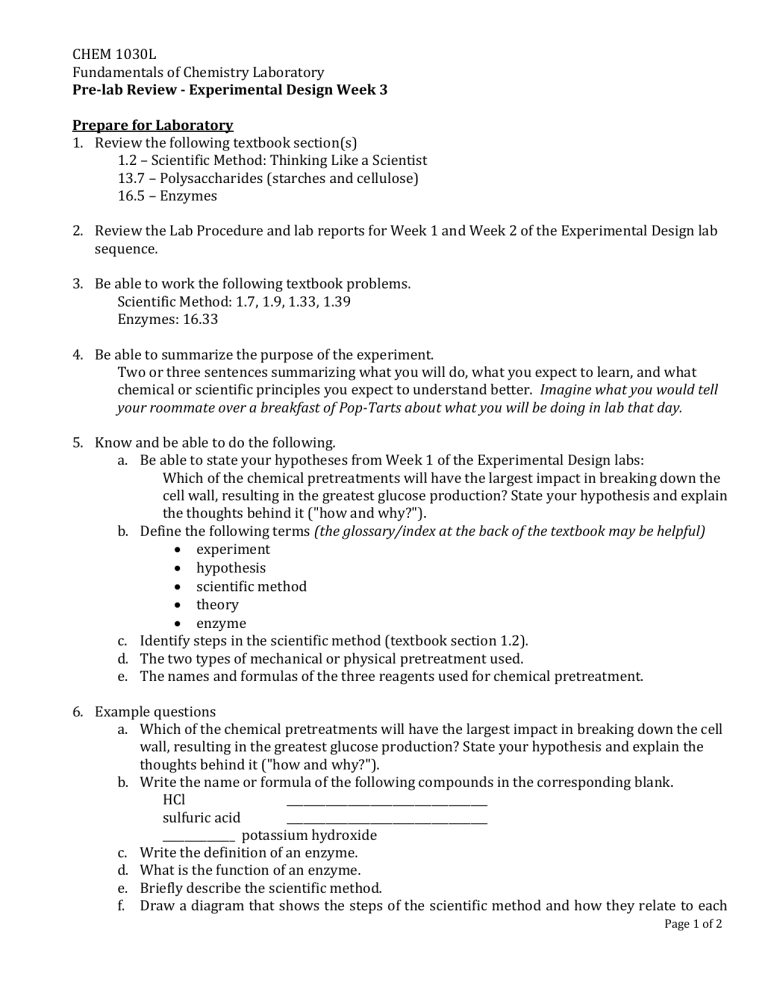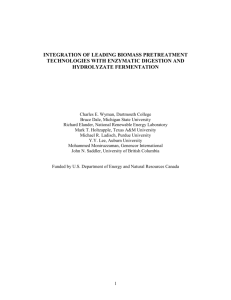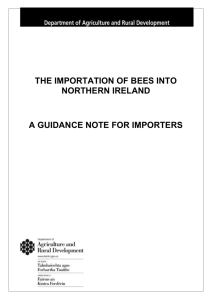Prelab Review

CHEM 1030L
Fundamentals of Chemistry Laboratory
Pre-lab Review - Experimental Design Week 3
Prepare for Laboratory
1.
Review the following textbook section(s)
1.2 – Scientific Method: Thinking Like a Scientist
13.7 – Polysaccharides (starches and cellulose)
16.5 – Enzymes
2.
Review the Lab Procedure and lab reports for Week 1 and Week 2 of the Experimental Design lab sequence.
3.
Be able to work the following textbook problems.
Scientific Method: 1.7, 1.9, 1.33, 1.39
Enzymes: 16.33
4.
Be able to summarize the purpose of the experiment.
Two or three sentences summarizing what you will do, what you expect to learn, and what chemical or scientific principles you expect to understand better. Imagine what you would tell
your roommate over a breakfast of Pop-Tarts about what you will be doing in lab that day.
5.
Know and be able to do the following. a.
Be able to state your hypotheses from Week 1 of the Experimental Design labs:
Which of the chemical pretreatments will have the largest impact in breaking down the cell wall, resulting in the greatest glucose production? State your hypothesis and explain the thoughts behind it ("how and why?"). b.
Define the following terms (the glossary/index at the back of the textbook may be helpful)
experiment
hypothesis
scientific method
theory
enzyme c.
Identify steps in the scientific method (textbook section 1.2). d.
The two types of mechanical or physical pretreatment used. e.
The names and formulas of the three reagents used for chemical pretreatment.
6.
Example questions a.
Which of the chemical pretreatments will have the largest impact in breaking down the cell wall, resulting in the greatest glucose production? State your hypothesis and explain the thoughts behind it ("how and why?"). b.
Write the name or formula of the following compounds in the corresponding blank.
HCl sulfuric acid
____________________________________
____________________________________
_____________ potassium hydroxide c.
Write the definition of an enzyme. d.
What is the function of an enzyme. e.
Briefly describe the scientific method. f.
Draw a diagram that shows the steps of the scientific method and how they relate to each
Page 1 of 2
other. g.
Name the three reagents used for chemical pretreatment. h.
Name the two types of mechanical or physical pretreatment used. i.
The four steps of the scientific method are experiment, conclusion, hypothesis, observations. Indicate the correct order of the steps of the scientific method by writing one of the four terms listed above in each of the blanks, below.
1st step _______________________________
2nd step _______________________________
3rd step _______________________________
4th step _______________________________ j.
Which of the chemical pretreatments will have the largest impact in breaking down the cell wall, resulting in the greatest glucose production? State your hypothesis and explain the thoughts behind it ("how and why?"). k.
Which of the following is a hypothesis based on an observation that bees are found buzzing around an outdoor recycling bin? a.
Bee stings are dangerous for persons who are allergic to bees. b.
Bees are insects. c.
The bees have found something sweet in the recycling bin. d.
Move the recycling bin and see if the bees follow it. e.
Spray the bees with insecticide.
Page 2 of 2











